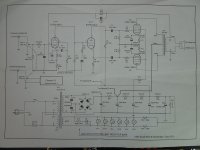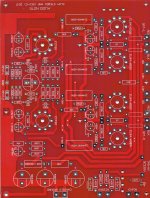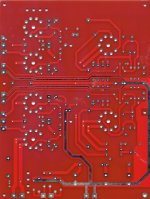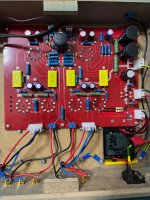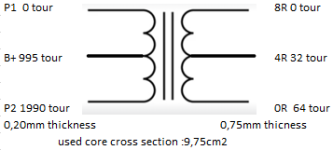Hi,
I have finished assembling the EL84 push pull lamp amplifier. The schematic and a photo of my amp are attached. The amp works fine with 8 ohm speakers. However, when we connect a 4 ohm speaker to the amp, there is an audio feedback high-pitched noise continius loop. I could not find a solution.
I have finished assembling the EL84 push pull lamp amplifier. The schematic and a photo of my amp are attached. The amp works fine with 8 ohm speakers. However, when we connect a 4 ohm speaker to the amp, there is an audio feedback high-pitched noise continius loop. I could not find a solution.
Attachments
That is very strange. If the sound was due to a stability issue, it would be worse if the amp were more lightly loaded, not more heavily. You say "when I connect a 4 ohm speaker" - are you connecting only one, and leaving the other side disconnected?
Check where your speaker wires are routed- make sure they are away from your input source and wiring. Are the speakers close to the amp? Do you hear any difference when you touch the tubes with something soft (in case of microphonics)?
Do some experiments and note the results, may help us narrow it down.
Check where your speaker wires are routed- make sure they are away from your input source and wiring. Are the speakers close to the amp? Do you hear any difference when you touch the tubes with something soft (in case of microphonics)?
Do some experiments and note the results, may help us narrow it down.
It sounds like the amp is borderline unstable. This is very possible when using anything other than the original OPT it was designed for. It's possible that the 4-ohm speaker is presenting a bit more of a capacitive load than the 8-ohm speaker, or otherwise tipping the amp into oscillation. Try disconnecting the global feedback (R16 and C8) and see if the problem persists. If it goes away, then the high-frequency compensation elements may need to be reworked (R8, C7 and C8). You would need an oscilloscope to do this properly.
The circuit looks pretty reasonable, but the first step is always to disconnect the feedback loop. The OP does not mention if this problem is in one or both channels.
All good fortune,
Chris
All good fortune,
Chris
Don't disconnect the feedback loop. This is a kit, not a custom recipe, and if built correctly will be as stable as all of the other dozens or hundreds of built examples have been. Trust the original design. I don't know if the OP has an oscilloscope and knows how to do feedback tuning. Do you fazildiken? First make absolutely sure the kit was built correctly. Answer the questions I have posed above.
This is a kit amp. Very well tested design.
Unless I'm mistaken, this is an AudioNote clone board from eBay, and the output transformers are not AudioNote. Real Audionote kits are built very differently from this. Also, the output transformer color codes do not match the schematic. The power transformer is not original either.
The build looks well done, but I suspect the feedback is causing some issues.
ETA: No, I see it's a genuine Audionote board, but I don't think the output transformers are AudioNote. I could be wrong.
Last edited:
Won't putting a 4 ohm load on the 8 ohm tap change the primary impedance? That would definitely affect the feedback loop.
I was not clear enough for everyone. Loop feedback is disconnected temporarily to test whether or not it's related to the oscillation problem. If the oscillation stops, we will search for a cause in one direction; if not, we must search in different directions. And we still don't know whether the issue is with one channel or both, so we don't know much yet.
All good fortune,
Chris
All good fortune,
Chris
So the terminals could easily be marked in the wrong polarity for feedback to be negative. Trust but verify.the output transformers are not AudioNote
All good fortune,
Chris
That is very strange. If the sound was due to a stability issue, it would be worse if the amp were more lightly loaded, not more heavily. You say "when I connect a 4 ohm speaker" - are you connecting only one, and leaving the other side disconnected?
Check where your speaker wires are routed- make sure they are away from your input source and wiring. Are the speakers close to the amp? Do you hear any difference when you touch the tubes with something soft (in case of microphonics)?
Do some experiments and note the results, may help us narrow it down.
I apologise for the delayed reply. It's the time difference.
- I have both 4 Ohm speakers connected and both have the same ear-splitting bad sound.
- Both speaker cables and output transformer primary cables are connected to the right place.
- Input cables are away from the installation and shielded cable. Keep in mind that there is no problem with 8 ohm speakers.
- The speaker is not very close to the amplifier, I will move it away and try.
It sounds like the amp is borderline unstable. This is very possible when using anything other than the original OPT it was designed for. It's possible that the 4-ohm speaker is presenting a bit more of a capacitive load than the 8-ohm speaker, or otherwise tipping the amp into oscillation. Try disconnecting the global feedback (R16 and C8) and see if the problem persists. If it goes away, then the high-frequency compensation elements may need to be reworked (R8, C7 and C8). You would need an oscilloscope to do this properly.
I calculated and wound the opt design myself.
8k primary impedance 0-4-8 secondary impedance.15w power. Minimum frequency 50hz. It works smoothly with 8ohm speakers. I cut the NFB. The bad sound is gone, but the sound quality is very bad. Unfortunately I don't have an oscilloscope.
The problem's on both channels.The circuit looks pretty reasonable, but the first step is always to disconnect the feedback loop. The OP does not mention if this problem is in one or both channels.
All good fortune,
Chris
As I wrote before, I cut the NFB. No more bad sound. But the sound quality is very bad. Could cutting the NFB have damaged the driver tubes? Yes, I'm Fazil Diken. I don't have an oscilloscope. This kit works fine with 8 ohm speakers.Don't disconnect the feedback loop. This is a kit, not a custom recipe, and if built correctly will be as stable as all of the other dozens or hundreds of built examples have been. Trust the original design. I don't know if the OP has an oscilloscope and knows how to do feedback tuning. Do you fazildiken? First make absolutely sure the kit was built correctly. Answer the questions I have posed above.
My opt has both 4 ohm and 8ohm outputs.Won't putting a 4 ohm load on the 8 ohm tap change the primary impedance? That would definitely affect the feedback loop.
Can you confirm that the polarity of your output transformers is as necessary for feedback to be negative? Forgive me if this is too obvious, but an error here is the most likely cause of the posted symptoms.I cut the NFB. The bad sound is gone, but the sound quality is very bad. Unfortunately I don't have an oscilloscope.
All good fortune,
Chris
I agree with Chris. Forgive me, I know nothing about winding transformers, but is it possible that only the 4 ohms taps are out of phase? That would account for howling (positive feedback) on those taps.
Yes, the amp will sound very bad with feedback disconnected. It's unlikely anything has been damaged.
I would try reversing the primary plate leads to the output tubes with the feedback connected and see if the noise continues at 4 ohms. Then test with the 8 ohm speakers. As Chris says the most important thing at this point is to determine if the transformer is operating in the correct phase for the feedback to be negative.
Yes, the amp will sound very bad with feedback disconnected. It's unlikely anything has been damaged.
I would try reversing the primary plate leads to the output tubes with the feedback connected and see if the noise continues at 4 ohms. Then test with the 8 ohm speakers. As Chris says the most important thing at this point is to determine if the transformer is operating in the correct phase for the feedback to be negative.
Forgive me, I did not know that you wound the output transformers yourself. I thought all parts came with the kit, so they would be tested, tuned, and guaranteed to work well together.
Disconnecting negative feedback will not damage your tubes or transformers. The sound is worse because there is no negative feedback to reduce the distortion.
Negative feedback in a tube amp is very dependent upon the design and behavior of the output transformer. Since you wound them yourself, the feedback network may be completely wrong for these transformers. In order to properly tune the feedback network, you are going to have to get an oscilloscope. You can get very cheap small ones that work great at audio frequencies. There may be oscillation that is above human hearing, that only the scope can see. You will also need to see the output response to a square wave input. Many of these cheap oscilloscopes have a signal generator built in- like this one here.
You will need to set it to a 1KHz square wave, and view the output waveform, take pictures and show us what you see, and we can go from there.
Disconnecting negative feedback will not damage your tubes or transformers. The sound is worse because there is no negative feedback to reduce the distortion.
Negative feedback in a tube amp is very dependent upon the design and behavior of the output transformer. Since you wound them yourself, the feedback network may be completely wrong for these transformers. In order to properly tune the feedback network, you are going to have to get an oscilloscope. You can get very cheap small ones that work great at audio frequencies. There may be oscillation that is above human hearing, that only the scope can see. You will also need to see the output response to a square wave input. Many of these cheap oscilloscopes have a signal generator built in- like this one here.
You will need to set it to a 1KHz square wave, and view the output waveform, take pictures and show us what you see, and we can go from there.
I am also very interested in your hand wound output transformers. Can you describe what core you used, and maybe post some pictures? Output transformers can be very difficult to design and build yourself. Manufactures are very careful to use just the right core material and construction to avoid magnetic saturation due to DC bias current, and use advanced winding techniques to achieve good frequency response. While the basic design of the transformer might be correct, they might not be functioning well. Is this the first time you have used these transformers?
- Home
- Amplifiers
- Tubes / Valves
- Tube Amplifier Audio feedback high-pitched noise continuous loop
